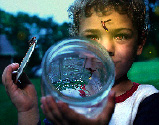


 Most of us have had the privilege of sitting on a porch
or boat seat and watching fireflies. Actually these fascinating
creatures are not flies, but nocturnal winged beetles. Interest
in
fireflies has grown in recent years as medical science has discovered
how to use the chemical processes of the firefly to address human
cellular energy problems. Cancer cells have energy problems and
can be
detected using the fireflies' processes for generating light.
Similar
uses have been found in treating breast disease, cystic fibrosis, and
multiple sclerosis.
Most of us have had the privilege of sitting on a porch
or boat seat and watching fireflies. Actually these fascinating
creatures are not flies, but nocturnal winged beetles. Interest
in
fireflies has grown in recent years as medical science has discovered
how to use the chemical processes of the firefly to address human
cellular energy problems. Cancer cells have energy problems and
can be
detected using the fireflies' processes for generating light.
Similar
uses have been found in treating breast disease, cystic fibrosis, and
multiple sclerosis.
Five components are used to produce the firefly's light:
The firefly has three layers in which the process is carried on. The outer layer is a transparent skeleton that sustains the light glowing process. The middle chamber has light cells which store the luciferin and luciferase. The inner-most layer acts as a reflector. It is packed with small uric acid salt crystals which have surfaces that reflect the light.
The firefly breathes in oxygen through a system of small air tubes controlled by nerves in the abdomen. This sets off a reaction aided by magnesium and ATP so the luciferase acts on the luciferin resulting in a flash of light. Virtually 100 percent of the energy generated is light where, as for comparison, efficiency is 10 percent for an ordinary light bulb with the rest being given off mostly as heat. About 1/40 cp (candlepower) is the brightness. Fireflies communicate with their flashes. The male, while it is flying, will flash about every five seconds. The female will stay on the ground and will flash once about two seconds later. The male will repeat its flashes and will fly toward the female until the two meet for mating. With practice, by the way, you can attract males with a flashlight.
 The chemical and physical
construction of this wonderful beetle is extremely complex. Not
only is
the chemistry highly complex with complicated compounds reacting in
controlled ways, but the apparatus in which the chemicals are contained
is carefully engineered to allow efficient transmission of energy as
light. Trying to construct a chance process that can do all of
this
requires multiple assumptions that have no reasonable mechanisms.
God's
wisdom and planning can be seen in the world all around us.
The chemical and physical
construction of this wonderful beetle is extremely complex. Not
only is
the chemistry highly complex with complicated compounds reacting in
controlled ways, but the apparatus in which the chemicals are contained
is carefully engineered to allow efficient transmission of energy as
light. Trying to construct a chance process that can do all of
this
requires multiple assumptions that have no reasonable mechanisms.
God's
wisdom and planning can be seen in the world all around us.
Source: Adrian Higgins, "Nature's Magical Little Night Lights," Washington Post (retrieved from the South Bend Tribune, July 28, 2007, page D7).
Back to Contents Does God Exist?, JulAug08.